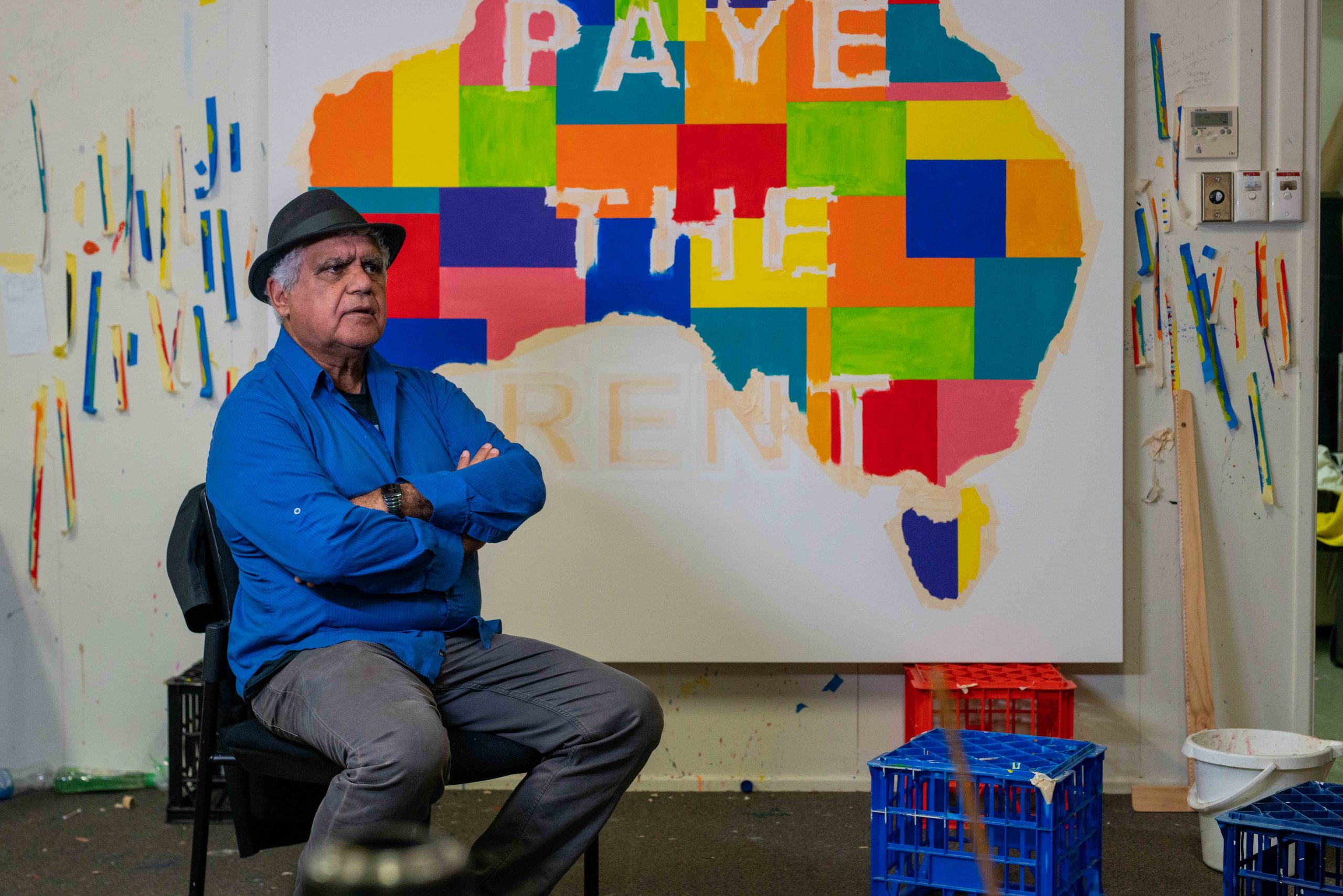Larissa Behrendt’s searing, essential documentary You Can Go Now introduces viewers to the world of Kamilaroi, Kooma, Jiman, and Gurang Gurang artist and activist Richard Bell. For many Australian viewers, this will be the first time they’re encountering Richard and his artwork. It’s art that blurs the line between art and activism, exploring the continued impact of colonialism in Australia, Indigenous art production, and global protest movements. As he says in his cheeky manner, ‘I’m an activist masquerading as an artist.’ By the close of You Can Go Now, you’ll be thankful for having spent eighty minutes with Richard, his fellow artists, activists, and peers, and if you’re a white viewer like me, you’re going to have your world view changed.
A bit of context is needed to appreciate the gravity of what Behrendt and Bell are presenting here. You Can Go Now arrives on the fiftieth anniversary of the establishment of the Aboriginal Tent Embassy in Canberra. It launches on the precipice of the Albanese government’s plans to hold a referendum to establish A Voice to Parliament which would enshrine Aboriginal and Torres Strait Islander people in the Constitution, allowing them to provide advice to the Parliament of the day on policies and projects that impact their lives. It also arrives in a year when the second Indigenous artist won the Archibald Prize, with Blak Douglas joining Vincent Namatjira (2020 winner) as the two Indigenous artists to have won the prestigious art award in its 101-year history.
To give these layered issues time to breath and be absorbed by the audience, Behrendt uses the dual approach of exploring Richard’s own history of artivism to detail the major political and societal events in Australian history that his artwork runs in parallel with. The use of archival footage – especially of the protests surrounding the Canberra Tent Embassy – is used brilliantly, often acting like a time machine that forces you to ask yourself ‘how has it been fifty years and Indigenous Australians are still having to fight for the rights to their land?’ As Bell outlines in the film, the move to establish an embassy within their own country was to be ‘seen internationally as a distress signal from the Aboriginal peoples on the land now known as Australia’[1].
Bell creates his own travelling Aboriginal Embassy, called Bell’s Embassy, where he tours it around the world to international exhibitions, including the Moscow Biennale, the Jakarta Biennale, New York, and Arnhem, Netherlands. This tour exhibition operates as a speaking place, an arena to allow ideas and stories of activism to be discussed openly and safely. Bell highlights the absurdity of being able to sit in conversation with fellow citizens from around the globe and discuss political ideas in this manner under the guise of it being an ‘art piece’ and it be accepted as such, whereas if the same individuals took to the streets to protest, voicing loudly those same ideas, their presence would be met with violence, the label of the act being ‘controversial’, and police aggression.
In 2013, white journalist Andrew Taylor wrote a piece for the Sydney Morning Herald about Richard Bell, titling it “Portrait of an artist as an angry man”. There’s a word that appears frequently in relation to Bell’s work: confrontational. It exists almost as a way of preparing audiences and viewers for the provocative manner that Bell talks about his work, and the messages that he puts in his art, but it also carries an air of “Angry Black Man” to it, almost as if it’s trying to diminish his activist journey. To be clear, Taylor’s piece isn’t trying to diminish Bell as an artist, even though it does try and make sense of his anger at the colonial structure of Australia and the manner that it diminishes Indigenous voices.
Bell frequently talks to the camera, staring straight down the barrel, knowing full well that a sizeable chunk of the audience demographic will be white folks with ties to European heritage. Splashes of colour cover the screen as he talks, amplifying key words that cut through in his monologues. It’s in these moments that the playfulness of Bell comes through as he knows he’s got your attention and intends to monopolise on it completely. He tells of his childhood in a shack in Queensland, a home that was demolished with many of his families’ belongings still in it. Bell’s artwork often critiques colonialism as he utilises the stylings of renowned artist like Roy Lichtenstein and Jackson Pollock, while elsewhere he documents major political events like Vincent Lingiari meeting Gough Whitlam, or the 1968 Black Power Salute at the Olympics.
In 2003 when Bell won the 2003 National Aboriginal and Torres Strait Islander Art Award for his painting Scientia E Metaphysica (Bell’s Theorem), he sent the media into a frenzy as he accepted the award wearing a shirt that had “White girls can’t hump” on it. Frustratingly, that shirt overshadowed the dialogue that Bell’s Theorem was stating: “Aboriginal art – It’s a white thing.” That art piece is paired with an extensive essay about what its critical and cultural intention is, namely:
Aboriginal Art has become a product of the times. A commodity. The result of a concerted and sustained marketing strategy, albeit, one that has been loose and uncoordinated. There is no Aboriginal Art Industry. There is, however, an industry that caters for Aboriginal Art. The key players in that industry are not Aboriginal. They are mostly White people whose areas of expertise are in the fields of Anthropology and “Western Art”. … key issues inter-relate to produce the phenomenon called Aboriginal Art and how those issues conspire to condemn it to non-Aboriginal control.
As detailed in a report by the Australian Productivity Commission, between 2019-2020 around $250 million of Indigenous art was sold in Australia. Of that art, only around one in three items sold was actually produced by an Indigenous artist or business.[2] This is Bell’s Theorem in practice, where Indigenous artists receive a minimal sum of money for their work, if they get paid at all. As Bell states, “There is no Aboriginal Art Industry,” and within You Can Go Now he fights for Aboriginal art to stand by itself, “Separate from, but equal to, Western art.”
I write this review with an Aboriginal art piece hanging on the wall next to me. In other rooms in my home, we have more Aboriginal art pieces hanging. I know where these pieces came from with them having been purchased directly from the artists themselves. I am part of the consumer industry that has been catered for with Aboriginal Art. You Can Go Now forces the white audience to sit with the notion that as we hang these works of art in our homes, and we talk about the artwork’s stories and importance with a well-meaning air of support that often comes across as moderately patronising, we do so on stolen land, we do so as injustices against Indigenous Australians escalate day by day, and we do so without a treaty in place.
Lest I start to paint this film as it’s a sermonising endurance test for white audiences, I want to stress that it is a film that’s full of immense hope, levity, and playfulness. Behrendt layers the film with notable Indigenous and Black figures, including Black Panther figure Emory Douglas, Aboriginal activist Gary Foley, and author Chelsea Watego, amongst many others, each talking about Richard’s work, their own activist journeys, and reflecting on 50 years of First Nations activism in Australia. This is a film that’s dense with history, with reverence for the figures who have fought the activist fight, and with a clear vision for the possibilities of the future.
If there’s a slight complaint that could be levelled against You Can Go Now, it’s that it is so densely packed with history, importance, and information that it can be hard to digest it all just after one viewing. I’ve barely scratched the surface of what is being detailed within You Can Go Now, especially in relation to the question of why Indigenous art is celebrated and lionised internationally, but domestically in Australia it’s often shunned in the shadow of the dominant white culture, but I’m beyond keen to dive back into this film, and next time I’ll bring a notepad.
Right now, Australia feels like a country that is on the precipice of an immense, monumental change, and Behrendt’s work (including the excellent After the Apology) speaks directly to the moment we are living within. The films close with each figure stating to the audience “You can go now.” To my white ears and eyes, this repeated request is less of a demand, and more of a request to decolonise the way you think and the world you live in, and to consider Indigenous folks when it comes to voting at the upcoming referendum.
Director: Larissa Behrendt
[1] https://richardbellart.com/project/embassy
[2] https://www.abc.net.au/news/2022-07-19/indigenous-art-industry-rife-with-inauthentic-artwork/101248898#:~:text=Around%20%24250%20million%20of%20Indigenous,an%20Indigenous%20artist%20or%20business.



